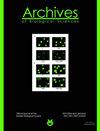Agmatine reduces chlorpromazine prooxidant effects in rat hippocampus and striatum
IF 0.8
4区 生物学
Q4 BIOLOGY
引用次数: 0
Abstract
The use of the antidepressant drug chlorpromazine (CPZ) is linked to the occurrence of oxidative stress in some brain structures. Thus, overcoming the side effects of CPZ is of great importance. Because agmatine (AGM) can act as a free radical scavenger, it is an interesting compound as an adjunct to CPZ therapy. The aim of our study was to investigate the enzymatic parameters of oxidative stress in the hippocampus and striatum of rats after CPZ treatment, and the potential protective effects of AGM. Rats were injected as follows with (i) 1 mL/kg b.w. saline; (ii) a single intraperitoneal (i.p.) dose of CPZ (38.7 mg/kg); (iii) CPZ (38.7 mg/kg) and AGM (75 mg/kg); (iv) AGM (75 mg/kg). CPZ induced an increase in superoxide anion radical (O2 ?-) concentration, while the activities of the antioxidant enzymes, superoxide dismutase (SOD), catalase (CAT), glutathione peroxidase (GPx) and glutathione reductase (GR), were lowered in both the hippocampus and striatum. Cotreatment with CPZ and AGM protected the examined brain structures by reversing the antioxidant enzyme activities to the control values. Following CPZ treatment, the effects were more pronounced for SOD and GPx in the hippocampus, and for SOD, CAT and GPx in the striatum. The full effect of restored superoxide production was achieved in the striatum, which points to the role of CAT. The obtained results suggest that CPZ in combination with AGM may be considered as a new treatment strategy.胍丁胺降低氯丙嗪在大鼠海马和纹状体中的抗氧化作用
抗抑郁药物氯丙嗪(CPZ)的使用与某些大脑结构中氧化应激的发生有关。因此,克服CPZ的副作用是非常重要的。由于agmatine (AGM)具有自由基清除剂的作用,因此它作为CPZ治疗的辅助药物是一个有趣的化合物。本研究旨在探讨CPZ处理后大鼠海马和纹状体氧化应激的酶学参数,以及AGM的潜在保护作用。给大鼠注射(i)生理盐水1 mL/kg b.w.;(ii)单次腹腔注射CPZ (38.7 mg/kg);(iii) CPZ (38.7 mg/kg)和AGM (75 mg/kg);(iv) AGM (75 mg/kg)。CPZ诱导大鼠海马和纹状体超氧化物阴离子自由基(O2 ?-)浓度升高,超氧化物歧化酶(SOD)、过氧化氢酶(CAT)、谷胱甘肽过氧化物酶(GPx)和谷胱甘肽还原酶(GR)活性降低。CPZ和AGM共处理通过将抗氧化酶活性逆转到控制值来保护被检查的大脑结构。CPZ处理后,海马中SOD和GPx以及纹状体中SOD、CAT和GPx的影响更为明显。在纹状体中实现了恢复超氧化物生产的全部效果,这表明CAT的作用。结果表明,CPZ联合AGM可能是一种新的治疗策略。
本文章由计算机程序翻译,如有差异,请以英文原文为准。
求助全文
约1分钟内获得全文
求助全文
来源期刊
CiteScore
1.40
自引率
0.00%
发文量
25
审稿时长
3-8 weeks
期刊介绍:
The Archives of Biological Sciences is a multidisciplinary journal that covers original research in a wide range of subjects in life science, including biology, ecology, human biology and biomedical research.
The Archives of Biological Sciences features articles in genetics, botany and zoology (including higher and lower terrestrial and aquatic plants and animals, prokaryote biology, algology, mycology, entomology, etc.); biological systematics; evolution; biochemistry, molecular and cell biology, including all aspects of normal cell functioning, from embryonic to differentiated tissues and in different pathological states; physiology, including chronobiology, thermal biology, cryobiology; radiobiology; neurobiology; immunology, including human immunology; human biology, including the biological basis of specific human pathologies and disease management.

 求助内容:
求助内容: 应助结果提醒方式:
应助结果提醒方式:


